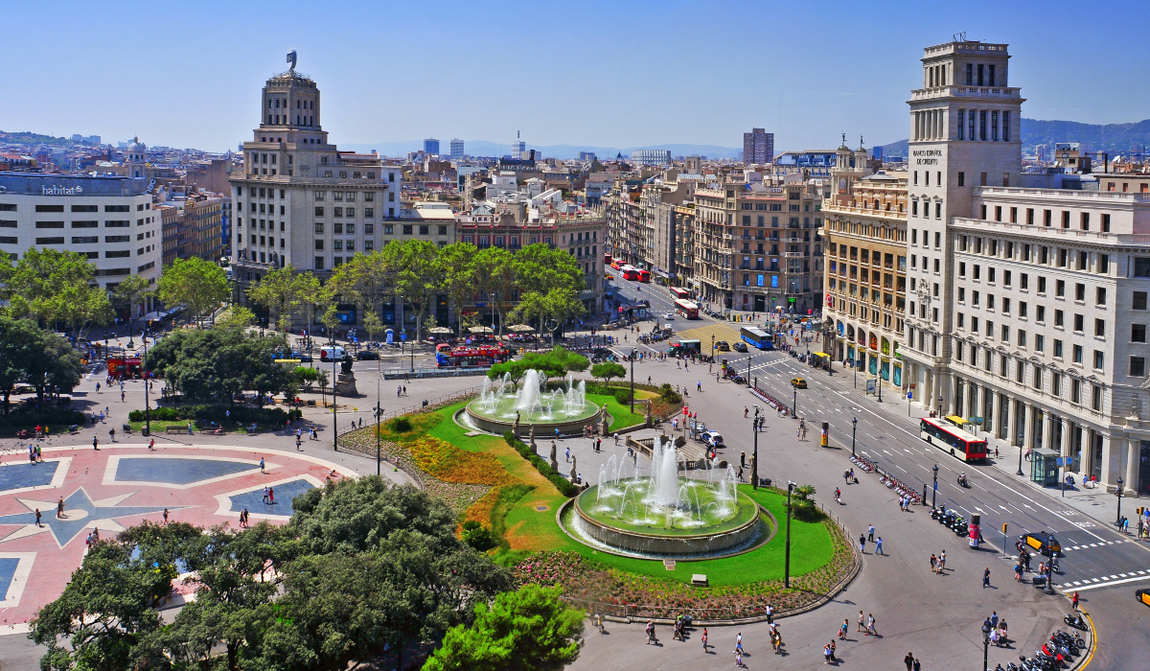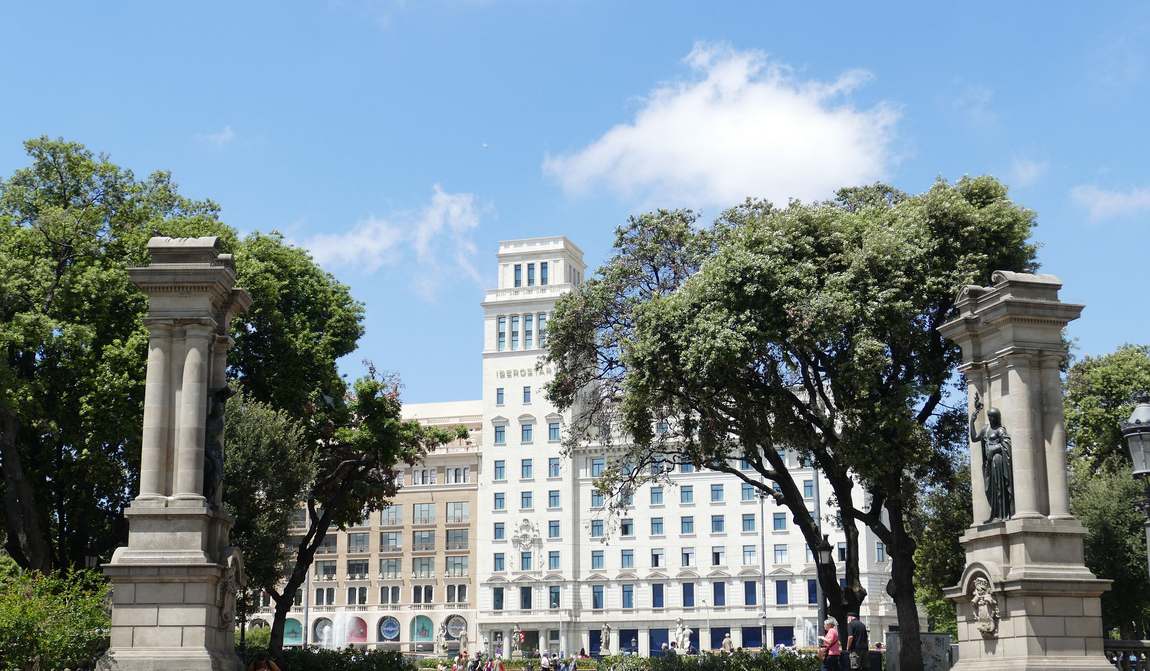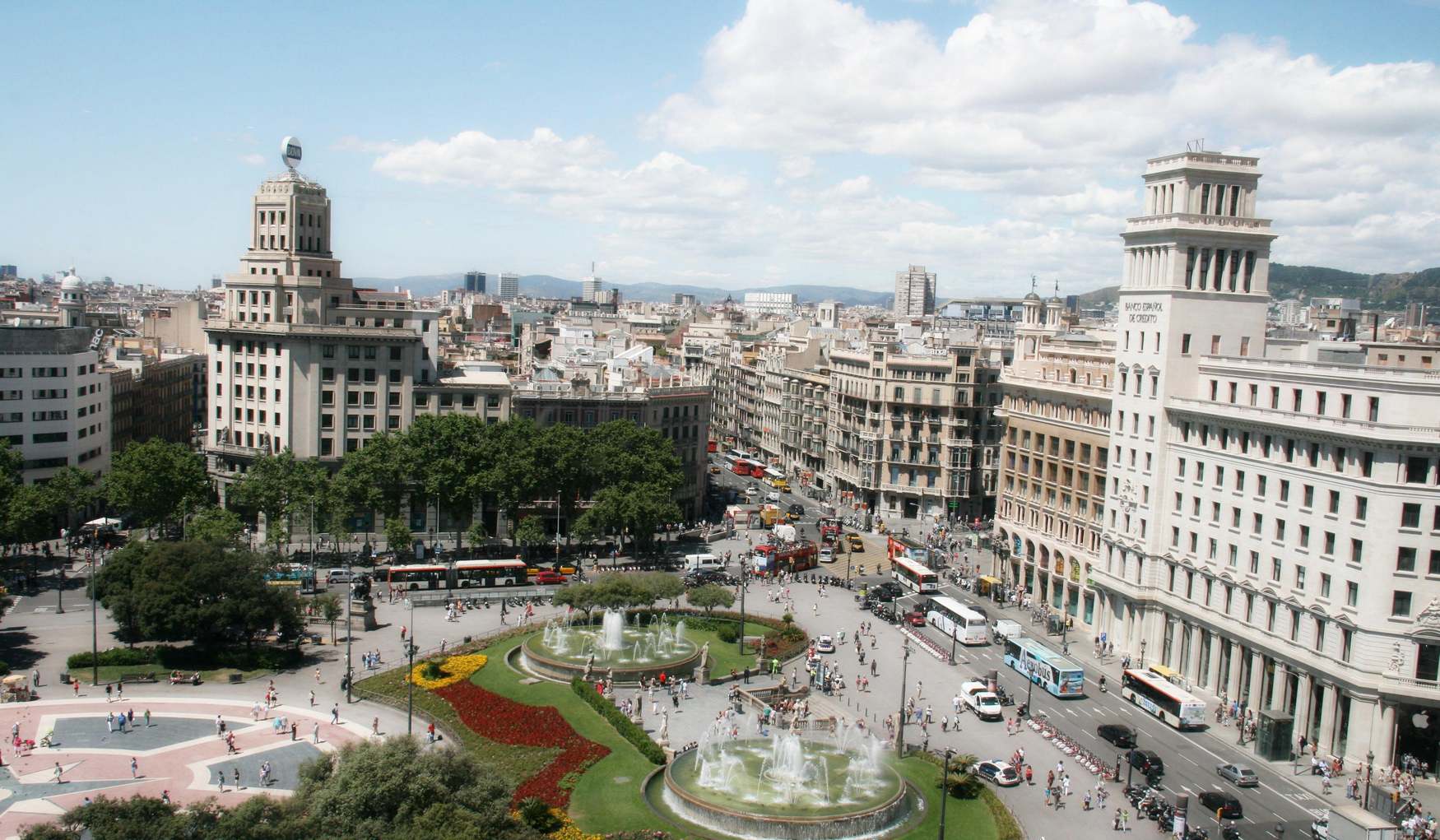Sightseeing tours of the city and walks in zoo parks are a thing of the past. Where else can you go with the children? — To Catalunya Square, of course. The beauty of the architectural ensembles, the great shopping opportunities, the delicious cafés and restaurants — it has everything for adults, kids and teenagers to relax and enjoy themselves.
The square is at the heart of Barcelona. The hub connects the main avenues of Passeig de Gracia with its excellent examples of modern architecture, Rambla de Catalunya and Portal de Angel, and the Old City and its Gothic Quarter to the densely populated Eixample district. The square can be considered a territory belonging to both the past and the present.
Surrounded by imposing buildings and two glorious fountains, the Plaza de Catalunya is decorated with numerous art exhibitions and famous sculptures.
It also has its urban legends. Underneath the square lies the mothballed Avenida de la Luz, one of the first metro lines to be shut down during the construction of the new lines. It is said that ghosts still live there.
The Plaza de Cataluña can show the natural diversity of the city; it is a place that brings together tourists and locals as well as objects of all kinds — shops, banks, museums, etc.

History of Plaza Catalunya in Barcelona
Barcelona's Plaza Catalunya covers 48,500 square metres and is considered a city symbol. It is often the venue for meetings between politicians and citizens, concerts and other public events.
The square has always been filled with cafés and restaurants that have been the centre of literary and political debates. To this day, they are one of the main meeting places for bohemians.
In the middle of the 19th century, Piazza Catalunya looked more like a lonely village than the city's centre. It was behind the city wall and was not considered part of Barcelona. In 1858, it was decided to remove the fortifications and start building up the area.
The city government called for bids for the project, and the architect Ildefons Kerd won. He designed the square as a sun, its rays spreading everywhere.
The first architectural compositions were dedicated to the 1888 World's Fair. Low houses appeared around the wasteland, tram lines were laid, and the centre of the square was planted with several trees; a couple of benches were installed, and a round lawn was arranged in the middle.
The general view was somewhat provincial, but the World Exhibition 1929 changed everything. First of all, a metro station appeared on Plaza Catalunya.
Then they began to design the square and began to install sculptures of famous masters on it — those that we see today. Only in 1991 the ensemble was replenished with a monument to Francesc Macia (monument of inverted stairs).
Description

Do not be indignant that many buildings do not carry architectural value since they were built during the reign of Franco when maximum attention was paid to the practical purpose of structures.
Some houses look massive and monotonous, but they have many shops where you can shop with the whole family. What buildings on the square have the most significant historical and architectural value?
Credit Bank of Spain
One of the grandest structures is the building of the Spanish Credit Bank (Banco Español de Crédito). The house was built in 1942 in the style of monumental classicism on the site of the 1902 Hotel Columbus.
Casa Pich y Pon
A high baroque tower separates the credit bank from the house of Pich y Pon, built in 1921 by the architect Josep Puig y Cadafalch for the entrepreneur, politician and mayor of Barcelona, Juan Pich y Pon.
The structure was built in Catalan neoclassicism (noucentisme — cat. "new century"), the hallmarks of which are orderliness, functionalism and the rejection of an abundance of decorative elements. An open layout characterizes the interior spaces.
Casa Rocamora
The unique design is by architect Joaquín and Bonaventura Bassegoda I Amigó, who built the building in 1917. The decoration of this building is the scaly orange-red towers that stand out against the austere façade with their brightness and somewhat playful variety of form.
The lovely, medieval castle-like house with fantastic balconies, ceramics and railings now houses an Armani shop.
Casa Rocamora is not a single building but an architectural complex united by a single, light-coloured stone façade. The mansion was designed for the Spanish artist, writer and art collector Manuel Rocamora y Vidal. His family lived in the house for several decades.
Casa Pascual y Pons
The house of Pascual y Pons is notable for its two completely different Gothic turrets (one round and the other faceted) at the corners of the facade and stained glass windows depicting people in medieval clothes. The balconies of the building are decorated with stone railings and forged railings.
The house was built in 1891 by the architect Enric Sagnier y Villavecchia for the Sebastià Pacual and Alexandre Pons families.
The interiors of Casa Pascual y Pons amaze with their luxury; they are decorated with marble stairs and wrought iron lamps. The lobby has a magnificent huge fireplace. Today the building houses offices, shops and restaurants.
Casa Bosch Alsina
The authors of the project of the house with turrets were the architects Bonaventure Conil y Montobbio, Joaquim Bassegoda y Amigo and his brother Pere. The building was constructed in 1892 by order of the doctor and owner of industrial enterprises Romulus Bosch i Alsina.
The masters preferred the historical style, which they filled with neo-Gothic elements.
Monuments and sculptures in Plaza Catalunya
.jpg)
In total, six sculptural compositions have been installed on Plaça de Catalunya. Four of them symbolize the provinces of Catalonia — Barcelona, Tarragona, Lleida (Lleida) and Girona, and the remaining two — Labour and Wisdom. What is remarkable about these sculptures, and what other monuments can be seen on the square?
«Labour and Wisdom»
The brothers Miguel and Luciano Osle created an expressive composition in which a man and a woman tame two rearing stallions. A man personifies labour (both physical and intellectual), and a woman personifies wisdom and knowledge.
Why do horses resist? Just because good work is not easy to do, as well as to gain deep knowledge, make the right decisions and do the right thing.
«Girona»
Sculptures by Antoni Parera symbolize the Catalan province of Girona. It is famous for its fertile lands, so, unsurprisingly, the master chose the guise of a cow loaded with a mountain of vegetables and fruits. The animal is accompanied by a tired but happy couple — a collective image of hardworking Catalans.
«Barcelona»
A large figure of a woman proudly sits on a mighty horse. Of course, this is a symbol of Barcelona — the epicentre of the social and political life of the region, an outpost of independent Catalonia.
The ship with raised sails on the shoulder of the stone lady is a tribute to all the discoverers and merchants who contributed to the city's prosperity. Mercury, the god of trade, an allegory of industry and shipping, leads the horse by the bridle. The work belongs to the sculptor and medalist Frederic Mares Deulovol.
«Tarragona»
The sculptural ensemble of several people in peaceful, relaxed poses is dedicated to the province of Tarragona. It symbolizes the world, vineyards and the sea, which is logical since the city is a world-famous resort.
Statue of Lleida
The idyllic composition, depicting three young women and two babies, is the work of Joan Borrell y Nicolau and personifies the Catalan province of Lleida.
The region is landlocked and shares a state border with Andorra and France. It is famous for its vast opportunities for shopping and gastronomic tours.
Memorial to Francesc Macia
Walking along the square, you cannot help but notice this monumental and rather unusual structure. A small bust with a fine and thoughtful expression stands in front of an imposing, irregularly shaped structure. Who is it, what is it, and which master's hand does this original creation belong to?
First, we need to say a few words about Francesc Macia. He is a genuine folk hero because, in 1931, he managed to proclaim an independent Catalan Republic. Nothing that it lasted only three days (true Catalans do not like to remember this too much), but Macia forever inscribed his name in the history of the separatist movement.
In 1977, the dictator Franco died, and the new democratic authorities decided to erect a monument to Francesco Macia. In 1983, the right to develop was given to the sculptor from Barcelona, Josep Maria Subirax, a talented craftsman known for his pro-Catalan views.
The bust of the national hero seems relatively small against the background of the pedestal — two inverted stairs made of travertine, which personify the annals of Catalonia. The first three steps of the composition's upper part are reinforced concrete and symbolize the period of Masiy's presidency.
The staircase ends abruptly, reminding the Catalans that their future is not predetermined and uncertain and that the region is always open to new achievements and developments.
Attached to the back wall of the pedestal is a steel sheet with the coat of arms of Catalonia and one of Francesc Macia's quotes.
l'Enigma
Many photos of Catalonia Square often show a sculpture of a woman staring pensively into the sky in the middle of a pond. The statue is made of white marble and belongs to the hand of Josep Clara.
The artist created his work in 1909 in Paris and named it 'Goddess' (the second title was 'Enigma'). The monument was not erected in the square until 1928.
It did not stay long in Barcelona, as some too active puritans expressed loud anger at the fact that the centre of the solid and respectable city was decorated with a naked female figure.
The sculpture was removed to end the already peaceful debate, but the day before the 1929 World's Fair, it was returned to its place. A few years later, the original statue was placed in the lobby of City Hall to save it from destruction. A replica created by Richard Sala appeared on the square.
Naviation
The woman leaning on the ship's rudder is the work of Eusebi Arnau and represents navigation — the science that allows sailors to reach their goals and return home in one piece.
Motherhood
Vicente Navarro has succeeded in creating a sculpture that is impressive in its expression. A woman's face with a baby in her arms expresses pride, suffering, courage and love simultaneously, in a word, the whole range of feelings that a mother experiences when raising her child.
There is a terrace between the two fountains, along which 1927, several sculptures of famous artists were installed. Among them is 'The Builder', the work of Josep Laimona (an exact copy in stone of the sculpture awarded at the 1914 International Art Exhibition in Brussels), a staunch advocate of Catalan Art Nouveau.
Other masterpieces include Joseph Viladomat's "Woman with Child and Piccolo", Enric Casanova's "Female Figure", Josep Dunyac's "Girl", Josep Clara's "Youth", and Pau Gargallo's "Shepherd with Flute".
Fountains in Plaza Catalunya

The twin fountains were designed and built in 1959 on the site of a typical shrubbery to give a more regular shape to the plaza area. Two circular concrete pools are connected by a terrace decorated with eight sculptures. The fountains attract attention with the contrast of large and thin jets and the graceful trajectory of the flows.
Until 2015, the fountains delighted tourists and locals only during the day. After the renovation, they put on a beautiful light show at night. Everyone is invited to watch the fantastic play of colours and water on Thursday and Sunday evenings.The Fountain of the Six Putti (Fuente de los Seis Putti)
The Fountain of Six Putti (Fuente de los Seis Putti) is situated in the eastern part of the square. It is decorated with figures of the Putti, divine babies like angels without wings.
Travel Tips
- When you're thirsty, you don't have to buy water in a shop. You can quench your thirst at one of the water fountains in the square for this purpose.
- If anyone in your family is a football fan, visit the official FC Barcelona shop to buy a blue-garnet T-shirt, a Messi portrait, and other souvenirs.
- There's also a bus stop close by, from where you can get to the airport or join a sightseeing tour of the whole of Barcelona.
- There's a metro station on the lower level of the square, where all three lines intersect.
- Fashion-conscious people who prefer to buy brand-name goods can visit the most expensive shops in El Corte Ingles and FNAC.
- Unlike the central squares of many other European countries, feeding pigeons on the Plaza de Catalunya is forbidden.
What else is there to see in Barcelona's Plaça Catalunya? At Christmas, you can see spectacular theatrical performances, buy exciting souvenirs, books and toys at the fair and even take part in sports competitions that are organised for adults and children.
Plaza de Cataluña is also home to the most famous chain of Hard Rock Cafés, where tourists love congregating.
Every September, the Festival of Our Lady of Mercy (La Merce) takes place in Plaça de Catalunya. It is one of the main celebrations for the people of Barcelona, during which performances are played that demonstrate the old traditions of Catalonia, as well as a variety of entertainment events.
Plaza Catalunya in Barcelona is marked on the city map, as are all the routes leading to it. You can use any public transport, either by bus or metro.
If you need more information or guidance, you can visit the Tourist Information Centre on the square. Here you'll get informational support, but you can also buy discount cards for various places of interest, cafés and restaurants, and bus tickets.
Plenty of hotels around the Plaza de Cataluña have family rooms, restaurants, parking, car rentals and other services essential for those travelling with children.











